Guitar Embellishments
Embellishments are techniques guitar players use to make the five pentatonic notes sound like hundreds of different notes. Here are a few you can try.
Slides
First we'll throw in a few slides. After playing a note, keep your finger on the string and slide it up to the next note. I've added solid arrows in a few places where you can do a slide using your third finger. Start on the 5th fret of the low E string.
(Notation: E5, A3-5 slide to 7, D5-7, G5-7 slide to 9, B string shift, B8-10, E8-10, side to 12)
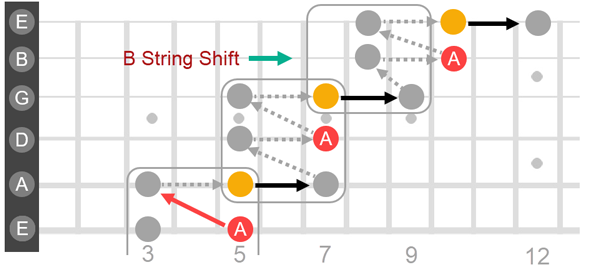
Here is the same sequence in reverse.
(Notation: E12 slide to 10-8, B10-8, G9 slide to 7-5, D7-5, A7 slide to 5-3, E5)
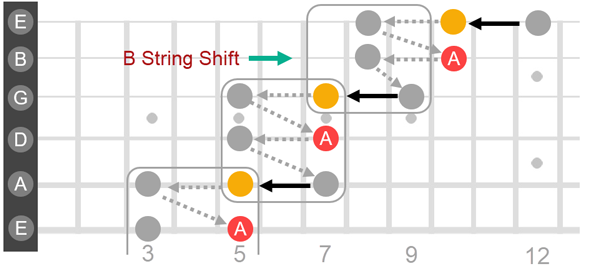
Adding the Blues Note
I'm skipping ahead a bit to let you include the blues note. I'll cover the blues scale later, but let this one note demonstrate how everything you learn, even one note, can enhance your improvisation. Every orange note has a blues note next to it. Turn your A minor backing track on and play a little of the blues.
(Notation: E5, A3-5-6-7, D5-7, G5-7-8-9, B8-10, E8-10-11-12, E15-17)

In this next sequence try sliding over the blues note. Slide slow enough so you can hear all three notes. Try this sequence in reverse.
(Notation: E5, A3-5 slide to 7, D5-7, G5-7 slide to 9, B8-10 slide to 12)
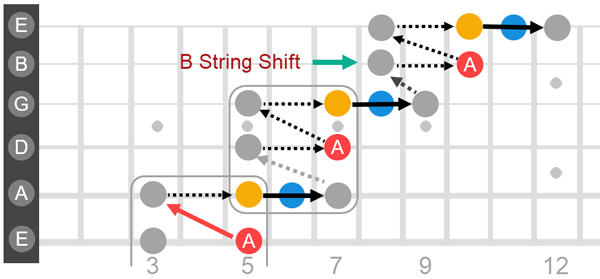
"Blues is easy to play, but hard to feel” — Jimi Hendrix
Finding the Key of a Song
Backing tracks will usually give you the key. You can also look up the chords for a song. Typically the first or last chord of the song will be the key. If a song starts and ends with the same chord, that's a stronger indication. If a song uses one chord more than any other, that's often the key of the song. You can also Google the key of a song or visit GetSongKey.com.
Double Stops
For a bluesy sound, you can throw in a few double stops. Double stops are two notes played at the same time. The notes are usually on adjacent strings and you play them both with the flat side of one finger. Strum both strings at the same time.
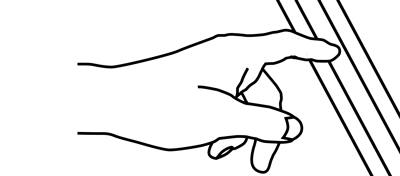
(Notation: E5, A3-5-6-7, D5-7, [B8+E8], [B10+E10], G8) Next reverse your steps.
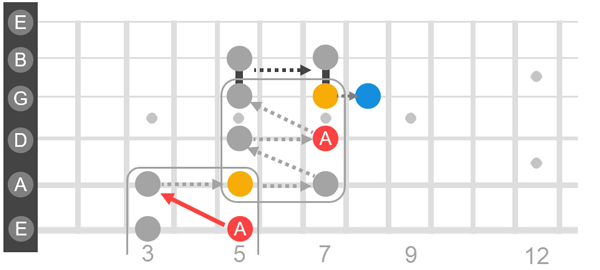
Famous Rows
Row 1 of a square is famous for its blues note. It also has an orange note for stepping squares and a gray note for side-stepping. Row 2 is famous for its root note and flat or dominant 7th. Row 3 is famous for a flat or minor 3rd, giving you the "sad" tone of a minor scale. It also has an orange note, on the right side, that's great for bending a half step up to another blues note, or a full bend up to the next scale tone.
Passing Tones
Every note you've played so far is a scale tone. The gray circle notes below are called passing tones. You can play them as long as you don't hang around to long. You can, for example, do a quick slide from a passing tone to a scale tone.

You can also use passing tones in a chromatic walk up or walk down. You do this by playing every note (half step) between two scale tones. Instead of rushing over the passing tones, you give them the same duration and emphasis as the scales tones. That's why they call it a "walk." You can walk at what ever speed sounds good.
With chromatic movement your brain is temporarily distracted from the solid feel of the song key, to a brain-pleasing sequence of ascending or descending notes. Of course you eventually have to land on a scale tone.
Here's an example of with chromatic walks. Start with a slide into the 5th fret of the high E string.
(Notation E4, slide E5, A3-5-6-7, D5-6-7, G5-7-8-9, B8-9-10, e8-10-11-12)
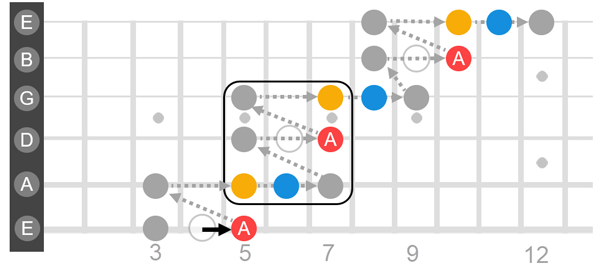
Bends
A great place to experiment with your first string bending is on the orange corner note in the third row of a square. Usually you're bending up a whole tone, like D to E. Starting out you'll tend to under bend, like D to Eb. That's not a problem because that Eb is the blues note. No one will know you were reaching for the E note and fell flat. "Hey, I'm just playing the blues."
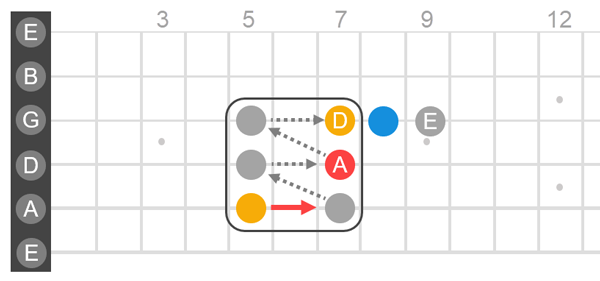
You can spend a life time learning new embellishments. Here, for example, is a partial list of ways you can play a single note.
Note
Muted
Vibrato
Staccato
Hammer on
Quick walk over
Pull off or multiple
Release bend to note
Trill, single or multiple
Quick slide off and back
Slide from above or below
Hammer on followed by pull off
Bend to note, whole or a half step
Chromatic walk from above or below